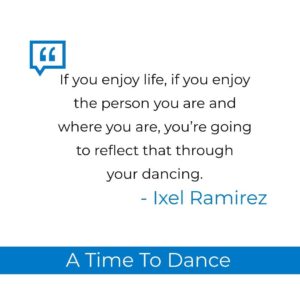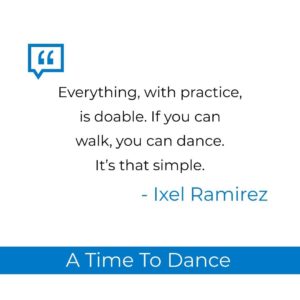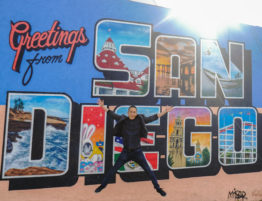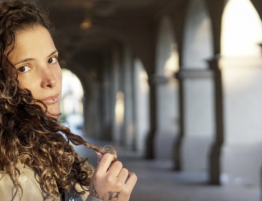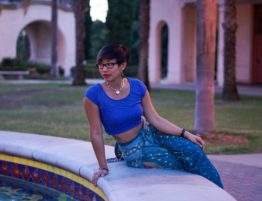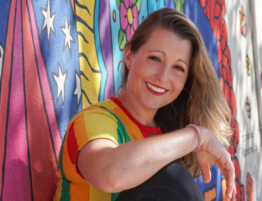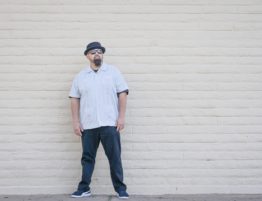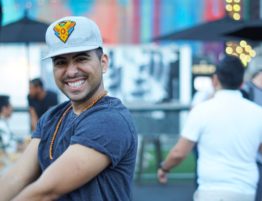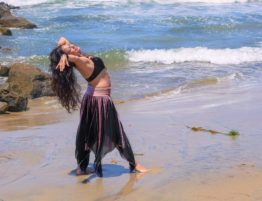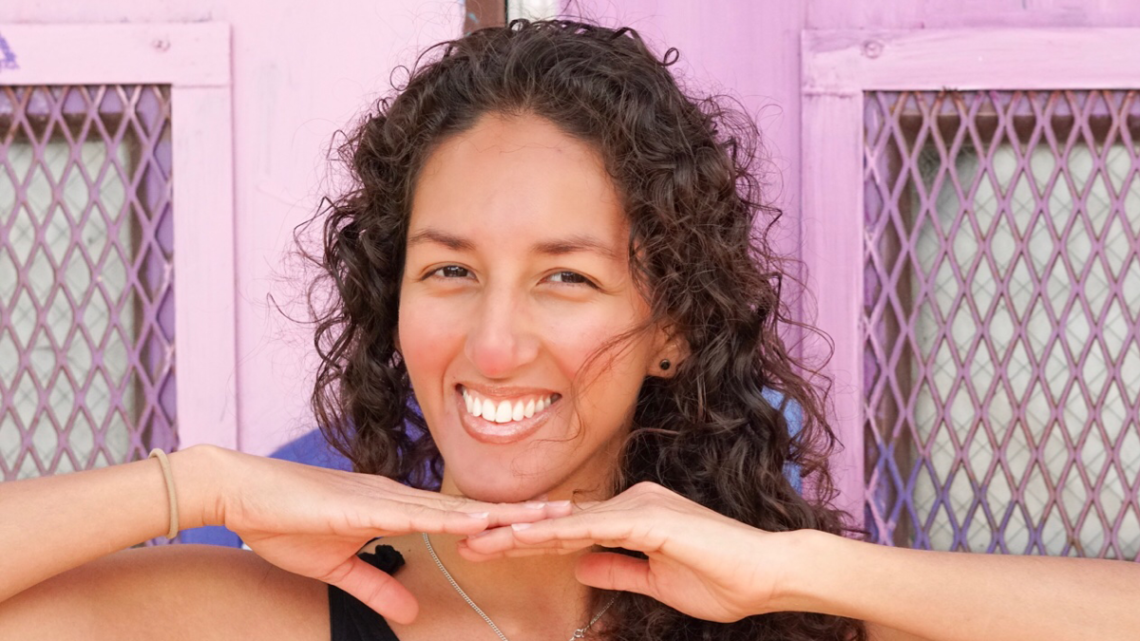
Ixel Ramirez is the voice behind every incredibly cheerful “What can I do for you?” on the A Time To Dance phone line.
She’ll book your rental space. She’ll give you the longest, warmest hug you’ve ever received in your adult life.
She’ll show you a kizomba move and social dance with you to just about any style.
And she will definitely make you smile.
We recently sat down with Ixel and asked her a few questions – questions about the crazy sequence of events that led her to San Diego, the real reason she loves kizomba so much, and her preferred ingredients for a great dance. Here’s what she had to say!
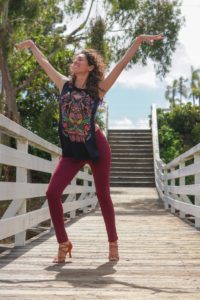
Q: What do you dance?
A: I dance life! I do salsa, bachata, kizomba, zouk, tango. I think that’s it!
Q: How did you get into kizomba?
A: I was originally taking tango lessons, but every time my teachers would go, “Stop moving the hips!” I would go, “Okay, I’m Latin, I can’t really stop moving my hips!“
I went to a salsa and bachata festival and there happened to be a kizomba class. I had never heard of kizomba before and had no idea what it was.
It was Tony Pirata and Sophie Fox dancing fusion kizomba. I saw them dancing in a close embrace like tango, but they were moving their hips like crazy! And I’m like, “Oh, I think this is something I can do!” I just loved it.
Q: And that’s how you started teaching?
A: In the beginning I was just sharing my passion and how I understood kizomba at the time. Or, I guess, my own version of kizomba back then!
I wanted to have people to dance with in Puerto Vallarta. When I started feeling more comfortable with what I knew, then some friends asked me, “Hey, let’s practice! Teach me what you learned at the festival!”
So, sure! I taught them the few moves that I knew and our little community in Puerto Vallarta began to grow.
Participating in ATTD’s classes has helped me tremendously as a dancer and teacher and I’m so excited to take what I have learned back to Puerto Vallarta.
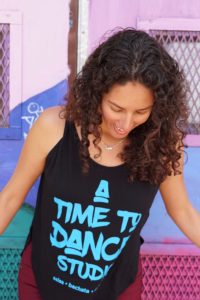
Q: How did you end up here in San Diego at A Time To Dance?
A: Funny story! So, I was at a festival – my life for the last six years has been festivals all over! For the last six years I have taken no vacations at all – just festivals!
I took a class with DJ Javi. He gave really important information that helped me with the way I danced. So I kept that in the back of my mind.
Then, maybe six months later, I went to a festival in Mexico City. At almost 4am, I noticed that the music started to change from the urban kizomba that we usually hear in Mexico to the more traditional kizomba. That’s what I enjoy the most!
So I was like, “I like this song! Oh, I like this other song! Oh, that’s a very cool song!” I got so excited. I was thinking, “This DJ is not Mexican! He’s not from here.” Most Mexican DJs were strictly playing only urban at the time. I simply had to find out who this person was. I went to the DJ booth and I ran into DJ Javi again!
We talked for I while and I ended up inviting him and A Time To Dance Studio to Puerto Vallarta to teach a workshop. Allen (also A Time To Dance instructor), Javi, and another teacher come to Puerto Vallarta. Later, we all went to the festival in Miami together.
It kind of became a nice group of people travelling together. When they invited me to visit San Diego, I was like, “Yes!” My eyes were like little hearts watching all of the kizomba events they had in San Diego and I was like, “I want to be there! I want to be part of that!”
Eventually it all worked out. Now I am here in San Diego at the studio as a volunteer! I think it was one of the best decisions I’ve ever made. I’m very happy to be here.
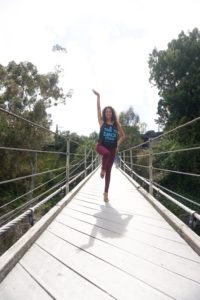
Q: For people who don’t know the difference between kizomba and urban kiz, can you talk about that?
A: Well, just like anything in life, I think dance also evolves. We are always changing. The world is always changing.
Kizomba was born as a mixture of other dances and music, like semba, zouk, and coladeira.
The people were exposed to various rhythms and styles, particularly when they migrated from Angola to different parts of Europe. The dance evolved from kizomba fusion to French style and eventually urban kiz, and then tarraxo, and many more!
In my opinion, that’s fine. There’s nothing wrong with expressing yourself in a different way. Of course, you have to understand the different styles so you are always well-informed, especially if you are trying to teach and be a promoter of these kinds of dances.
The same thing happened with bachata. The same thing happened with salsa. All these different dances have evolved with time.
Kizomba, I think, is a more grounded dance. It feels more to the earth, with drums and instruments that you can actually play and touch. The music of ghetto zouk and urban kiz is more synthetic. The sounds are more from a computer. That’s how I understand it in my own words.
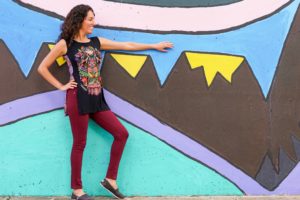
Q: My impression is that while you enjoy both kizomba and urban kiz, you are more drawn to kizomba. Why is that?
A: I think it comes down to my grandparents!
I grew up with them since I was six years old. I heard music like son cubano and Argentine tango. They are these old-fashioned, more traditional sounds.
I didn’t grow up listening to pop or hip hop. The traditional music is closer to me. I enjoy that the most. I like the rumba from Cuban and the Afro-Cuban drums. I feel the beats! I feel them inside, in the chest! It makes me feel into the music.
Q: You’re always smiling when you dance. It’s obvious that it makes you happy! What makes a good dance for you when you are dancing with somebody?
A: Connection. As long as it feels honest. I love when it feels transparent.
Sometimes you are dancing with someone who knows a lot of tricks, but they’re just looking to see who is looking at them! It can be a good lead and a fun dance, but it’s not as connected.
So, it doesn’t matter to me what style or how advanced they are, if there is that connection, that’s what I enjoy the most!
I also try to give that to my partner when I dance. If you enjoy life, if you enjoy the person you are and where you are, you’re going to reflect that through your dancing.
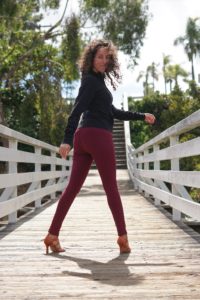
Q: Anything exciting coming up at A Time To Dance
A: ATTD definitely wants to add classes in the morning and kids classes. Those are the two main projects.
Q: Do you have events?
A: There is always something going on! Every month we have Urban Night, organized by the studio, at Tango del Rey. It has kizomba, zouk, and bachata. That’s the second Saturday of the month. We also hold different workshops throughout the year. You have to follow our social media!

Q: Any encouragement for people who want to dance but are maybe nervous to get started?
A: The funniest thing I hear all the time is, “I always wanted to learn and take classes, but I don’t know how to dance.”
That’s what classes are for! You don’t have to know how to dance in order to take classes! Just jump right in. If you never try, you’re never going to find out if you’re actually good at it. And if you’re not good at it, you just need to practice more. That’s all.
Everything, with practice, is doable. If you know how to walk, you can dance. It’s that simple.
Popular dances like kizomba or bachata were generated by the people dancing in the streets. It’s not something that a professional dancer designed and said. “I’m going to create this dance and teach people how to dance it.”
No! Nobody was born already knowing how. Anybody can do it. It’s just a matter of making the decision to get out there.
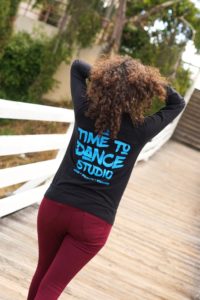
Q: Awesome! That’s definitely motivational. Anything else that you would like to add?
A: If you see me on the dancefloor, save me a dance! Dance with me!
Ixel Ramirez is an instructor and the manager at A Time To Dance Studio in San Diego, California.
Follow A Time To Dance on social media:
Instagram @atimetodance.sd
Facebook A Time To Dance Studios
Heather Hallahan
Latest posts by Heather Hallahan (see all)
- Q&A with Kevin Qin: An Engineer’s Journey To Finding Purpose In Teaching Salsa - Thu, January 30, 2020
- Q&A With Ruana Vasquez: Valuing Women In Brazilian Zouk - Sat, December 14, 2019
- Q&A With Elizabeth Kilrain: Who Gets To Say What Blues Is? - Mon, November 25, 2019

